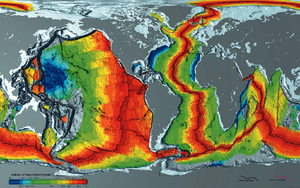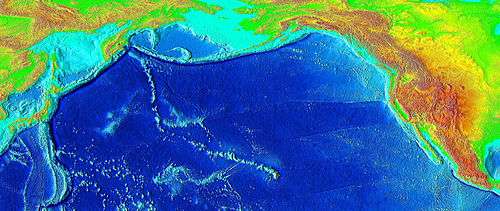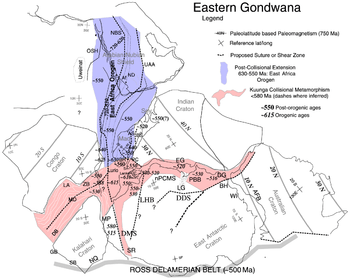Plate reconstruction
- This article describes techniques; for a history of the movement of tectonic plates, see Geological history of Earth.
Plate reconstruction is the process of reconstructing the positions of tectonic plates relative to each other (relative motion) or to other reference frames, such as the earth's magnetic field or groups of hotspots, in the geological past. This helps determine the shape and make-up of ancient supercontinents and provides a basis for paleogeographic reconstructions.
Defining plate boundaries

An important part of reconstructing past plate configurations is to define the edges of areas of the lithosphere that have acted independently at some time in the past.
Present plate boundaries
Most present plate boundaries are easily identifiable from the pattern of recent seismicity.[1] This is now backed up by the use of GPS data, to confirm the presence of significant relative movement between plates.
Past plate boundaries
Identifying past (but now inactive) plate boundaries within current plates is generally based on evidence for an ocean that has now closed up. The line where the ocean used to be is normally marked by pieces of the crust from that ocean, included in the collision zone, known as ophiolites.[2] The line across which two plates became joined to form a single larger plate, is known as a suture.
In many orogenic belts, the collision is not just between two plates, but involves the sequential accretion of smaller terranes. Terranes are smaller pieces of continental crust that have been caught up in an orogeny, such as continental fragments or island arcs.
Reference frames
Plate motions, both those observable now and in the past, are referred ideally to a reference frame that allows other plate motions to be calculated. For example, a central plate, such as the African plate, may have the motions of adjacent plates referred to it. By composition of reconstructions, additional plates can be reconstructed to the central plate. In turn, the reference plate may be reconstructed, together with the other plates, to another reference frame, such as the earth's magnetic field, as determined from paleomagnetic measurements of rocks of known age. A global hotspot reference frame has been postulated (see, e.g., W. Jason Morgan) but there is now evidence that not all hotspots are necessarily fixed in their locations relative to one another or the earth's spin axis.[3] However, there are groups of such hotspots that appear to be fixed within the constraints of available data, within particular mesoplates.[4]
Euler poles
The movement of a rigid body, such as a plate, on the surface of a sphere can be described as rotation about a fixed axis (relative to the chosen reference frame). This pole of rotation is known as an Euler pole. The movement of a plate is completely specified in terms of its Euler pole and the angular rate of rotation about the pole. Euler poles defined for current plate motions can be used to reconstruct plates in the recent past (few million years). At earlier stages of earth's history, new Euler poles need to be defined.[3] It was suggested recently that paleomagnetic Euler poles derived from apparent polar wander path could potentially extend the upper age limit of marine geophysical observations and hot spot traces.[5]
Estimating past plate motions

In order to move plates backward in time it is necessary to provide information on either relative or absolute positions of the plates being reconstructed such that an Euler pole can be calculated. These are quantitative methods of reconstruction.[6]
Geometric matching of continental borders
Certain fits between continents, particularly that between South America and Africa, were known long before the development of a theory that could adequately explain them. The reconstruction before Atlantic rifting by Bullard based on a least-squares fitting at the 500 fathom contour still provides the best match to paleomagnetic pole data for the two sides from the middle of Paleozoic to Late Triassic.[6]
Plate motion from magnetic stripes
Plate reconstructions in the recent geological past mainly use the pattern of magnetic stripes in oceanic crust to remove the effects of seafloor spreading. The individual stripes are dated from magnetostratigraphy so that their time of formation is known. Each stripe (and its mirror image) represents a plate boundary at a particular time in the past, allowing the two plates to be repositioned relative to one another. The oldest oceanic crust is of Jurassic age, providing a lower age limit of about 175 Ma for the use of such data. Reconstructions derived in this way are only relative.[6]
Paleomagnetic pole data
Sampling
Paleomagnetic pole data is obtained by taking oriented samples of rock. Good quality poles have been recovered from many different rock types. In igneous rocks, the magnetic minerals have cooled through the curie point, typically providing good quality poles. Metamorphic rocks may contain new magnetic minerals but are not normally used to obtain poles due to their typically high magnetic anisotropy. Sedimentary rocks generally have a complex set of magnetic components such as derived clasts and mineral grains with their own inherited magnetization, primary magnetization acquired at the time of sedimentation and secondary magnetization related to subsequent diagenesis and authigenic mineral growth.[7] Progressive demagnetization is used to discriminate between the components to identify the primary magnetization. The poles shown by the primary magnetization represent a record of their position relative to the magnetic pole at the time when the rock was formed. Suitable rocks of the right age are not present everywhere, so some pieces of the puzzle remain very unconstrained.
Good quality magnetic poles are added to the Global Paleomagnetic Database, which is accessible from the World Data Center A in the USA at Boulder, Colorado; and from the Norwegian Geological Survey in Trondheim.[8][9]
Apparent polar wander paths
Poles from different ages in a single area can be used to construct an apparent polar wander (APW) path. If paths from adjacent crustal fragments are identical, this is taken to indicate that there has been no relative movement between them during the period covered by the path. Divergence of APW paths indicates that the areas in question have acted independently in the past with the point of divergence marking the time at which they became joined.[10]
Observed paleomagnetic poles show only the approximate latitude at the time but provide no constraint on the longitude. For this reason older plate reconstructions have much larger uncertainties associated with them. Paleomagnetic Euler rotations (rotation poles and angles) and the mantle structures, however, could provide clues to this longstanding challenge.
Hotspot tracks

The presence of chains of volcanic islands and seamounts interpreted to have formed from fixed hotspots allows the plate on which they sit to be progressively restored so that a seamount is moved back over the hotspot at its time of formation. This method can be used back to the Early Cretaceous, the age of the oldest evidence for hotspot activity. This method gives an absolute reconstruction of both latitude and longitude, although before about 90 Ma there is evidence of relative motion between hotspot groups.[11]
Slab constraints
Once oceanic plates subduct in the lower mantle (slabs), they are assumed to sink in a near-vertical manner. With the help of seismic wave tomography, this can be used to constrain plate reconstructions at first order back to the Permian.[12]
Apparent polar wander paths geometric parameterizations
Paleomagnetic Euler poles derived by geometrizing apparent polar wander paths (APWPs) potentially allows constraining paleolongitudes from paleomagnetic data. This method could extend absolute plate motion reconstructions deeply into the geologic history as long as there are reliable APWPs.[5]
Other evidence for past plate configurations

Some plate reconstructions are supported by other geological evidence, such as the distribution of sedimentary rock types, the position of orogenic belts and faunal provinces shown by particular fossils. These are semi-quantitative methods of reconstruction.[6]
Sedimentary rock types
Some types of sedimentary rock are restricted to certain latitudinal belts. Glacial deposits for instance are generally confined to high latitudes, whereas evaporites are generally formed in the tropics.[13]
Faunal provinces
Oceans between continents provide barriers to plant and animal migration. Areas that have become separated tend to develop their own fauna and flora. This is particularly the case for plants and land animals but is also true for shallow water marine species, such as trilobites and brachiopods, although their planktonic larvae mean that they were able to migrate over smaller deep water areas. As oceans narrow before a collision occurs, the faunas start to become mixed again, providing supporting evidence for the closure and its timing.[6]
Orogenic belts
When supercontinents break up, older linear geological structures such as orogenic belts may be split between the resulting fragments. When a reconstruction effectively joins up orogenic belts of the same age of formation, this provides further support for the reconstruction's validity.[6]
References
- ↑ Condie, K.C. (1997). Plate tectonics and crustal evolution (4th ed.). Butterworth-Heinemann. p. 282. ISBN 978-0-7506-3386-4. Retrieved 2010-02-21.
- ↑ Lliboutry, L. (2000). Quantitative geophysics and geology. Springer. p. 480. ISBN 978-1-85233-115-3. Retrieved 2010-02-22.
- 1 2 Kearey, P.; Klepeis K.A. & Vine F.J. (2009). Global tectonics (3rd ed.). Wiley-Blackwell. p. 482. ISBN 978-1-4051-0777-8.
- ↑ Pilger, R.H. (2003). Geokinematics: prelude to geodynamics. Springer. p. 338. Retrieved 2010-02-21.
- 1 2 Wu, L.; Kravchinsky V.A. "Derivation of paleo-longitude from the geometric parametrization of apparent polar wander path: implication for absolute plate motion reconstruction". Retrieved 10 February 2014.
- 1 2 3 4 5 6 Torsvik, T.H. "Reconstruction Methods". Retrieved 21 February 2010.
- ↑ Merrill, R.T.; McElhinny M.W. The earth's magnetic field: its history, origin, and planetary perspective. International geophysics series. 32. Academic Press. p. 401. ISBN 978-0-12-491240-3. Retrieved 2010-02-21.
- ↑ National Geophysics Data Center (2010). "IAGA Paleomagnetic Databases". Retrieved 21 February 2010.
- ↑ Geological Survey of Norway (2005). "Global paleomagnetic database". Retrieved 21 February 2010.
- ↑ Butler, R.F. (1992). "Chapter 10 Applications to paleogeography" (PDF). Paleomagnetism:Magnetic domains to geologic terranes. Blackwell. Retrieved 22 February 2010.
- ↑ Torsvik, Trond Helge; Steinberger, Bernhard (December 2006). "Fra kontinentaldrift til manteldynamikk" [From Continental Drift to Mantle Dynamics]. Geo (in Norwegian). 8: 20–30. Retrieved 22 June 2010., translation: Torsvik, Trond Helge; Steinberger, Bernhard (2008). "From Continental Drift to Mantle Dynamics" (PDF). In Trond Slagstad; Rolv Dahl Gråsteinen. Geology for Society for 150 years - The Legacy after Kjerulf. 12. Trondheim: Norges Geologiske Undersokelse. pp. 24–38. Retrieved 18 June 2010 [Norwegian Geological Survey, Popular Science].
- ↑ van der Meer, D.G.; Spakman W.; van Hinsbergen D.J.J.; Amaru M.L. & Torsvik T.H. (2010). "Towards absolute plate motions constrained by lower-mantle slab remnants" (PDF). Nature Geoscience. Macmillan Publishers Limited. 3: 36–40. Bibcode:2010NatGe...3...36V. doi:10.1038/NGEO708. Retrieved 22 November 2011.
- ↑ Scotese, C.R. (2002-04-20). "Climate History". Paleomap Project. Retrieved 22 February 2010.
External links
- "The PLATES Project, a comprehensive resource with reconstructions, movies, images, list of publications, and teaching resources". University of Texas Institute for Geophysics at the Jackson School of Geosciences.
- Scotese, Christopher. "The Paleomap Project, with reconstructions in the past and future, paleogeographies, teaching material etc.".
- Pindell, James. "Plate reconstructions (with animations) for the Caribbean Plate". Tectonic Analysis Ltd.
- "Global plate reconstructions with velocity fields from 150 Ma to present in 10 Ma increments". Geodynamics group at the Geological Survey of Norway.
- "EMAGE: East Antarctic Margin Aeromagnetic and Gravity Experiment". Alfred Wegener Institute for Polar and Marine Research.
- Paleomaps Since 600 Ma (Mollweide Projection, Longitude 0)
- Paleomaps Since 600 Ma (Mollweide Projection, Longitude 180)